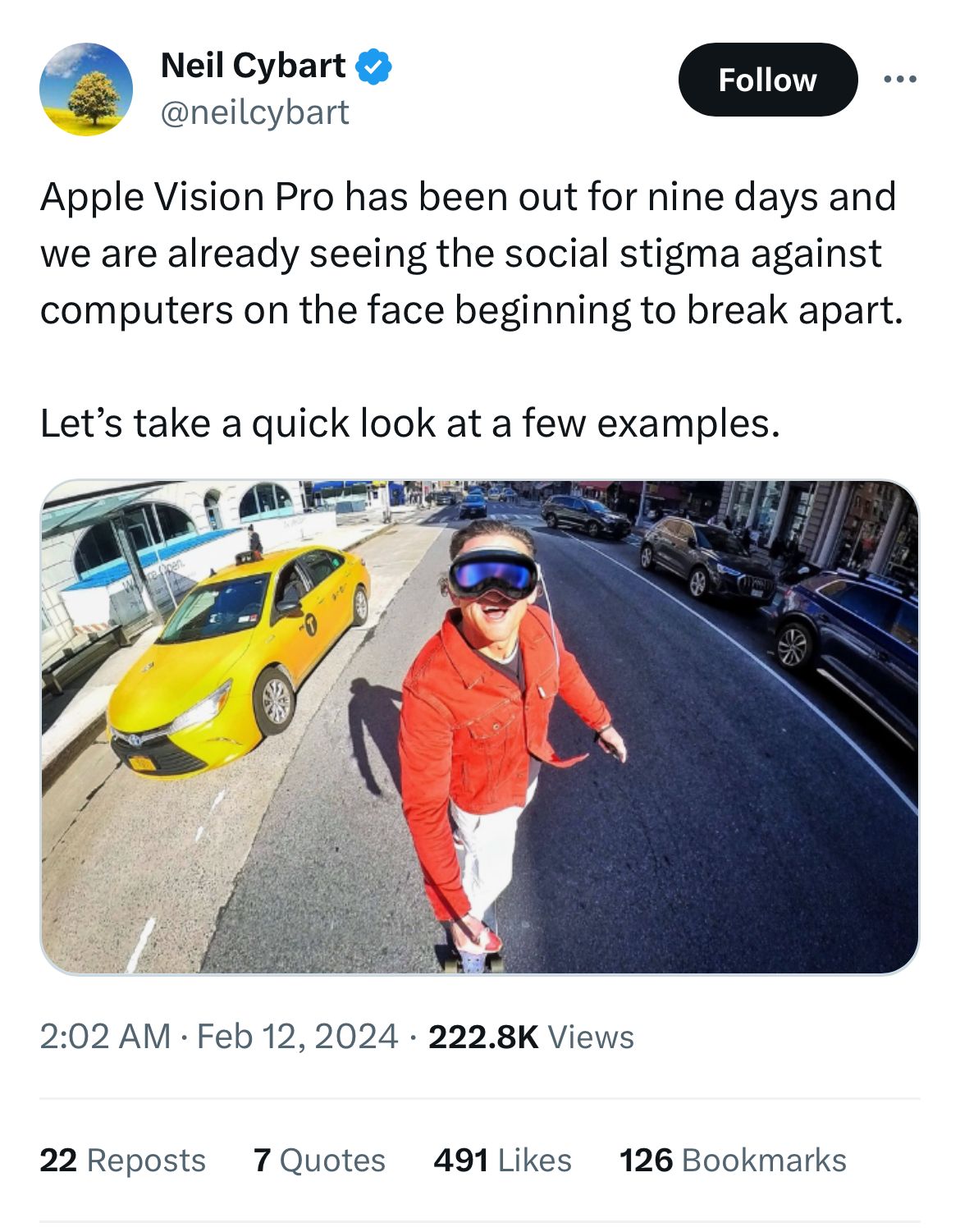Highlights
- Vision Pro challenges societal norms for wearable tech with broad public engagement.
- Analysts predict full societal acceptance by the 4th generation of Vision Pro.
- Over half of Vision Pro apps require a purchase, marking a shift in app monetization.
- Vision Pro’s initial reception counters the backlash faced by predecessors like Google Glass.
Since its debut, Apple’s Vision Pro has grabbed public attention, not just for its groundbreaking technology but also for the unique place it occupies in the cultural zeitgeist.
Unlike its predecessors in the realm of wearable tech, the Vision Pro has embarked on a journey that merges innovation with a pivotal factor – societal integration, a feat that earlier devices like Google Glass struggled to achieve.
However, it also seems like most experts are saying that not until the 4th generation of the Vision Pro, will consumers turn to mass acceptance of the Apple’s Spatial Computing headsets.

This comes in the backdrop of another report by TechCrunch saying that most apps for the Vision Pro at launch are not free to use.
Let’s dive into everything in more detail.
The Societal Dance of Acceptance

The streets have become a stage for Vision Pro users, from celebrities like T-Pain, Diplo, and Casey Neistat to content creators and early adopters, showcasing the device in scenarios ranging from the whimsical to the outright fantastical.
While these public displays often border on the theatrical, they may actually be a critical role in normalizing the presence of such devices in everyday life.
Analyst Neil Cybart points out that this wave of “silliness” may be disarming potential resistance, paving the way for a more accepting view of wearable AR/VR technology in public spaces.
Something that Google just couldn’t do with its Google Glass.
The Legacy of “Glassholes”

Tech enthusiasts might remember that Google Glass, an early foray into smart glasses, encountered a significant cultural backlash, with wearers often met with skepticism or outright hostility.
This went to such an extent that the term “glassholes” became a shorthand for the social faux pas of donning tech that seemed to infringe on privacy or simply appeared out of place.
In contrast, the Vision Pro’s reception has leaned more towards curiosity and amusement, suggesting that perhaps the way forward for wearable tech is not just in the sophistication of the hardware but in the approach to its societal introduction.
A Four-Generation Journey

However, the Vision Pro is categorically a first-gen product.
The acceptance for something so early comes with its set of challenges and expectations.
Historically, diving into the first iteration of an Apple product has been seen as a leap of faith, with the understanding that subsequent versions will refine and perfect the initial concept.
Mark Gurman from Bloomberg suggests that the Vision Pro is currently a ‘Prototype’ and said that Apple employees believe that it will hit its stride by the fourth generation, indicating a long-term vision for its development.
The complexity and potential of integrating AR/VR technology into daily life is huge but Apple is one company you can trust to make it widely acceptable.
Vision Pro App Ecosystem: A Mixed Monetisation Model

The Vision Pro’s app ecosystem reveals a nuanced approach to monetization.
While a significant portion of Vision Pro-specific apps are paid downloads, a contrast to the broader trend of free downloads with in-app purchases on the App Store, there’s also a strong lean towards subscription models.
As per Appfigures, statistics indicate that over half (53%) of the apps designed exclusively for Vision Pro require payment at the time of download.
The App Store for Apple’s other products has only 5% of apps that demand an initial purchase.
Furthermore, Appfigures reveals that 35% of Vision Pro apps do not engage in any form of monetization via the App Store, and a smaller fraction (13%) utilize subscription models for revenue.
All in all, it feels that Apple is on a path to extract even more money for the full Vision Pro experience, as if the ginormous $3,500 price tag was not enough.

FAQs
What sets the Vision Pro apart from previous wearable tech like Google Glass?
Vision Pro has been met with curiosity and amusement, unlike Google Glass, which faced significant backlash due to privacy concerns and social acceptance issues.
Why do experts believe the Vision Pro will achieve mass acceptance by its 4th generation?
The gradual refinement and societal normalization of AR/VR technology, combined with Apple’s track record of improving products over successive generations, suggest a broader acceptance in the future.
How are apps for Vision Pro different in terms of monetization compared to other Apple products?
A notable 53% of Vision Pro-specific apps are paid downloads, contrasting sharply with the App Store’s broader trend where only 5% of apps require upfront payment.
What role does public display and celebrity engagement play in the Vision Pro’s societal acceptance?
Public displays and celebrity usage of Vision Pro help normalize the device in everyday life, mitigating potential resistance and fostering a more accepting view of wearable AR/VR technology.
How does the Vision Pro’s app monetization strategy affect users?
With over half of Vision Pro apps being paid and a smaller portion offering subscriptions, users may need to invest more in the ecosystem to fully leverage the device’s capabilities.
Also Read: Apple Vision Pro Once Lost, Cannot be Located on the Find My Network
Also Read: Apple Vision Pro visionOS 1.1 Beta Rolling Out With MDM Support: Here’s What You Need to Know
Also Read: Sam Altman Hails Apple Vision Pro as the ‘Second-Best’ Tech Marvel After the iPhone
